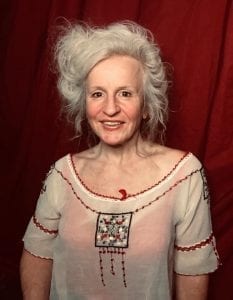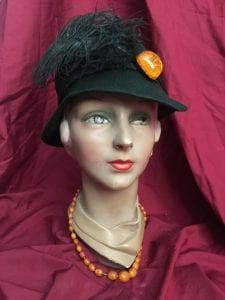Davenport Woman’s Passion For Fashion Takes Her To “Hollywood”
They say clothes make the man. They also make Laura Heath very happy, especially when they authentically evoke a specific era.
With her husband, Heath owns Trash Can Annie’s 418 E. 2nd St., Davenport, which has been closed to the public since last spring’s historic flooding. But her 40-year passion for fashion and experience working in theater and film nationwide led her to another high-profile project last year – supplying clothes for the hit Netflix mini-series “Hollywood,” which debuted May 1.
The Ryan Murphy-led production — lauded for its glamorous, pitch-perfect costuming — is set in the 1940s, postwar Tinseltown, and creates a revisionist, more progressive social history of the period. Heath – who’s run her downtown business 22 years – has worked for shows on Broadway, Juilliard in New York, Chicago’s Steppenwolf and Goodman theaters, and provided hundreds of garments for the 1997 blockbuster film “Titanic.”

Laura Heath wearing an ethnic blouse from the ’30s.
Like most of these productions, “Hollywood” came about from word of mouth — a costumer in New York City, who had been in her shop, called last July and recommended Heath to costume designer Sarah Evelyn Bram in Los Angeles. Heath loves how the authentic Netflix series looks.
“The clothing is impeccable; she did a phenomenal job,” she said recently. “It’s interesting for me, as I watch the scenes, I remember her calling me and she didn’t use anyone’s names, she just said we need these kind of pieces for this kind of scene and this sort of thing is going on, so what kind of thing do you have that would look appropriate?”
“It was a lot of work. But since I’ve done this thing before, I understand what’s going on and how it’s done. It was just a little topsy-turvy with what was going on with the flood, and my life had basically been turned upside down.”
“The style is impeccable; it’s a nostalgic look that I love, people love. It just looks great. People are connected to it because I think a lot of people romanticize that time. If they lived it, they might not think the same.”
Bram was equally impressed with Heath.
“Trash Can Annie’s was great,” she said recently by e-mail. “She’s lovely and cares and she’s responsive. In addition, she has a lot of 1940s clothes, which is not so common,” she said.
When Heath talked to Bram last summer (about two months after the record-breaking flood deluged downtown), she told her she was able to save the majority of her clothing inventory, but would normally just pull stuff right off the rack.
“In light of what had just happened in my life, it was not quite the same,’ Heath recalled. “So, she was very understanding of that. When the people in California talked to me, she understood completely, and would figure it out, and we did.”
Of the lavish seven-episode series (which features Patti LuPone, Darren Criss and Jim Parsons), a Vogue review called it “a beautiful show to watch, full of bright colors and brimming with spectacular costumes.

Vintage hat from the 1930s.
“There are bold women wearing bold suits; young starlets cinched into embroidered pencil skirts topped off with tiny cardigans; men with giant lapels and high-waist trousers; and plenty of old-school Oscar gowns too,” the piece said. “Many of the ensembles recall trends that are relevant today, like the loose suiting for women or the cardi-and-skirt sets. Glamour has evolved, but one fact remains true eight decades later: Wherever there is glamour, there is a way to be carried off somewhere else, to a different time, a different place, and the clothes in this show are what help to get us there.”
“With a lot of vintage, it has a specific reason it’s cut the way it’s cut,” Heath said. “During wartime, there were no women’s skirts that were pleated because it used too much fabric. It was a war ration that you couldn’t use excessive amounts of fabric for things.”
She’s a fan of series creator and executive producer Murphy (“Glee,” “American Horror Story,” “The Politician”), who has a $300-million deal with Netflix, the most lucrative TV pact in history. She admires his consistently high production values, and the specific look he creates for each project.
“They were extremely particular, but they should be,” Heath said of “Hollywood.” “I respect that entirely. If you’re gonna do a period film, you dress everyone in period clothing.”
“They want it to be the exact piece. No matter how good it looks, it needs to be the original. I understand that,” she said. “They wanted to make sure it was 100-percent vintage, and I think that’s fantastic.”
Shopping vintage as a teenager
A Cedar Rapids native, Heath started shopping at Trash Can Annie’s (founded in 1978) when she was 14, and the store was on Brady Street. She’d visit twice a year and buy 10 to 20 pieces at a time through her 20s.
Heath has always loved fashion from the turn of the 20th century, the late ‘30s and early ‘40s, and the ‘60s, including menswear. “It’s always been that women who have a love of fashion are drawn to menswear, ‘cause there’s a clean, classic flair to menswear.”
“I always had a love for textiles and early on, with my parents’ clothing and my grandparents’ clothing, I would wear their pieces,” she said. “They said you can continue to wear it, as long as you take good care of it. I’ve always been that way with my clothing.”
“My parents and grandparents had great taste in clothing, knew how to put things together well,” she said. “My parents instilled in me, buy quality pieces, because there’s fad in fashion.”
Heath moved to the Q-C in 1984, had planned to be a chiropractor, but met someone and didn’t finish school. She worked selling antiques several years before taking over Trash Can Annie’s, which moved to its 2nd Street spot next to Ragged Records 11 years ago.
Heath knew the original owner, who passed away from an asthma attack at a young age; her partner was older and wanted to retire. The former partner said since Heath had a collection from the shop, she asked her to take over the business.
A brush with the Oscars
One of her biggest projects was costuming the 1997 film, “Titanic” (for 12 years the top-grossing movie in the world, raking in $2.2 billion at the box office).
“Someone in L.A. who shopped at Trash Can Annie’s knew we had the kind of inventory we did, and called to ask. She asked for that movie,” Heath recalled of the cinematic epic, which dramatizes the 1912 sinking of the luxury ocean liner. She supplied immigrants’ clothing and undergarments, for “hundreds” of actors.

Vintage hat from the 1930s.
It was hard to find the clothes they needed, literally undergarments in perfect condition. Fortunately, over the years, Heath has bought a lot, including men’s undershirts in the original packaging. “It goes from that mundane, to extremely extravagant. I just try to keep my eyes open for all those things.”
“It’s a lot of work to do it right and a lot of work to do it well,” she said of “Titanic.” “It’s wonderful to be part of it. I think it was a great movie. I tell people, with anything, if somebody thinks something isn’t one way or the other – have you tried doing it? Have you tried making a movie?”
“I give people credit for everything, because I think it’s not so easy as it looks,” Heath, who’s had many customers come to her to sell their vintage outfits. “When people make it look easy, it’s because they do it well.”
She had a part in earning the James Cameron movie one of its 11 Oscars, for Best Costume Design. Her name, however, never appears on screen and she doesn’t mind.
“The reasoning for me that’s not such an important thing is, the credits go by so quickly anyway, the fact of the matter for me is, I’d like our name out there so other costumers know us, through other customers. not by seeing it in credits,” Heath said. “It’s just like anything – word of mouth is the best thing.”
She dressed Cillian Murphy for the 2010 psychological thriller “Peacock,”: and actors for Woody Allen’s “Sweet and Lowdown” (1999), “a massive amount,” including the dress the female lead wears on the DVD cover. The film was set in the 1930s and starred Sean Penn.
“It is particularly cool to look back, to see that hat, those shoes. I buy it, someone needs it, I get it to them, it goes into production and you see it,” Heath said. “For me, that’s exciting.”
“With the amount of productions we’ve done, people know – even from smaller theaters…When the time comes again to do another production, they think of us.”
Sewing up a great review
Costume designers know her reputation and she gets work mostly by word of mouth.
“That’s why I was able to do this,” Heath said of “Hollywood.” “There are so many people from all over who say, ‘Oh yeah, I know Trash Can Annie’,” Heath said.
For many years, she’s worked with providing clothes to the famed Juilliard School of Drama in New York City, which helped lead to her outfitting actors (including Vanessa Redgrave) for the 2003 Broadway revival of “Long Day’s Journey Into Night.” The towering drama, also set in 1912, co-starred Brian Dennehy and Philip Seymour Hoffman, with costume design by frequent Woody Allen collaborator Santo Loquasto.

Laura Heath wearing an Asian shirt from the ’30s.
“They said they needed a particular garment for this particular scene in the show, and I said, I understand you’re asking for something, and you want it to be light in color, but I think I should send you something that’s gray,” Heath recalled of that show.
“They said, we’re looking for something more a pink tone. I said, I understand that and I know, but do you mind? I sent it, the costumer looked at it, and said, ‘That’s absolutely perfect’,” she said. “Fortunately, I have done things long enough.”
At first, designers used to send hand-drawn renderings for productions, she would pull pieces that could work. Then, “if they said they needed a day dress from the 1930s in a spring color palette, I would know what to look for,” Heath said.
“They didn’t need to send me a drawing of it. Like they said, not everyone was like me, and some people needed more direction. That was one of the reasons a lot of places like to work with me continually – because I got it and I understood that.”
She has worked with Circa ‘21 costumer Greg Hiatt, and provided clothes for most all the Q-C theaters, including some high schools, but she’s never been costume designer for productions.
A flood of emotions, casual Friday too far
Though Heath is still planning a new location for Trash Can Annie’s, more than a year after being flooded out last May, she luckily had the foresight to get friends to move much out of the store before it was overtaken by water damage.
“We were really savvy about getting things out of the shop,” she said. “We had a sixth sense the night before, this was gonna happen. We got into the shop early in the morning.”
Other friends, including Chad Pregracke and his crew (of Living Lands and Waters) got Ragged Records’ vinyl and Heath’s inventory mostly packed up and moved. “The vast majority of textiles were saved, but we lost cases and fixtures and it’s still raw, hard to talk about.”
Heath is also sad that many people don’t take pride or the time to dress themselves well, especially compared to the late ‘40s era that “Hollywood” perfects.
“They used to take a huge amount of pride in the way they dress,” she said. “Casual Friday has gone too far. People let things be lax in the workplace and just in general, when you’re out. If you’re wearing pajama bottoms in public, does that mean you wear a gown to bed? It just doesn’t make sense.”
“I think people just aren’t aware how easy it is to dress stylish,” Heath said. “So they put things on that are comfortable, but not necessarily appropriate for outside of the house.”
The biggest thing is people aren’t comfortable shopping, or willing to go beyond what they always wear. That’s why I love styling,” she said. In the past month or so, Heath also has used social media to get the word out that she’s available as a personal fashion consultant.
For a variety of fees, she can dress people for events, recommend a wardrobe for work or leisure, how to pack for traveling, and peruse their closets. “Everybody needs to go into their closets, say these are core pieces that are perfect, need to mix things up, others be donated or kept,” she said. “Everyone has as closet that needs to be updated and curated.”
Her artistic eye extends to interior décor and photography. Heath and her husband Bryan (who works in counseling) live in a 1932 home in Davenport, bought 25 years ago. They meticulously renovated it to include saturated colors in each room, which has a different theme (e.g., the living room is Greek and Egyptian, dining room is Far East).
“Otherwise, you have a house full of things that don’t really belong. If you theme it together, it looks cohesive,” she said.
Shades of gray in photos
Four years ago, Heath really started getting into photography, based on her interest in vintage clothing and anatomy. She works mostly in black and white, specializing in nudes and portraiture, and has exhibited three times at Rozz-Tox in Rock Island.
She described her striking images as mysterious, reminiscent of 1930s and ‘40s film noir, and she’s inspired by the work of Herb Ritts, Sally Mann, and Edward Weston’s images from the early 1900s. “The willingness of my models inspires me, for them to be daring; and being daring makes the photo true art,” Heath said.

Photos for “Power Frauen” exhibit at German American Heritage Center, Davenport.
“Having the ability to see things the way I do with vintage, is equally as interesting as the kind of photography we do,” she said. “Whether there is clothing or isn’t clothing, there still has to be something that’s well-balanced for the eye.”
She prefers to shoot black-and-white because “it gives more depth to an image, and you clearly feel more nostalgia,” she said. Heath works with Ragged Records’ owner Bob Herington to create just the right lighting for each subject.
“I like doing different levels of light. I like the idea of very low light,” she said.
Heath is among 17 Q-C women artists represented in the current “Power Frauen” exhibit at German American Heritage Center & Museum, at 2nd and Gaines streets, on notable German, Austrian and German-American women. You can see it here at under “Virtual Museum”).
Heath created a photo triptych in tribute to trend-setting German-American actress/singer Marlene Dietrich (1901-1992). The women in the photos emulate famous images of Dietrich, including two who are bare-chested. Heath said the actress “really was cutting-edge for her time.”
“My love for vintage clothing and early 20th-century photography and lighting made this a perfect fit with my current direction, for its nostalgic simplicity,” Heath wrote in the exhibit panel at GAHC.
“I was instantly drawn to Marlene because of her bold imagery. I chose to use models that could have a look that was timeless, with a hint of modern aesthetic. I wanted to combine the true vibe and era of Marlene, but also incorporate my photographic style,” she wrote.
“Marlene was an extraordinary woman who dared to bring gender equality to the forefront. From overcoming obstacles and breaking rules, she chose to adopt the wearing of men’s trousers and other mannish clothing, making her a trendsetter. She helped launch an American fashion style that persists into the 21st century. She behaved like a man, the characters she played loved power and often donned menswear.”
“Her masculinity appeals to women and her sexuality to men,” Heath wrote. “Her personal allure went far beyond her masterful and androgynous image and her glamour.”
The GAHC description of her photos says viewers should leave with a greater “appreciation of the human form, as she sees it through her camera. There is a graphic simplicity to her work that allows the viewer to feel her work instantaneously.”
“Power Frauen” at GAHC is timed to the 100th anniversary of the 19th Amendment to the U.S. Constitution, giving women the right to vote. The first-floor exhibit talks about suffrage in Germany, when it was adopted in America, and how the women featured in the exhibit were all trailblazers in their own right, across a variety of fields.
You can see more of Heath’s images at lauraheathphotography.com. To contact her, visit her Facebook page or Instagram.









